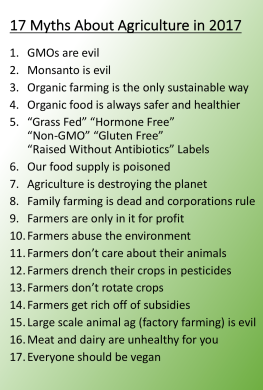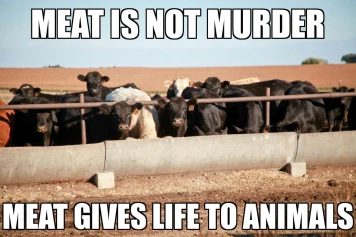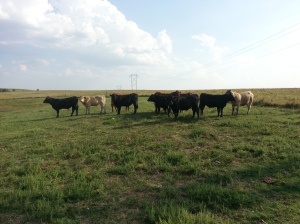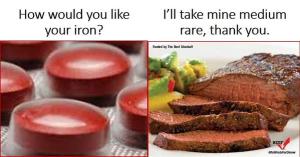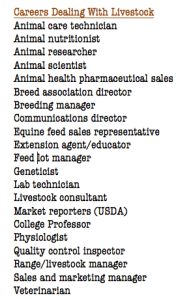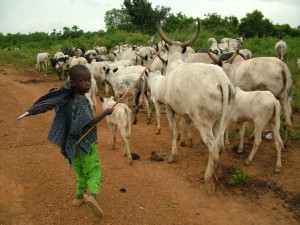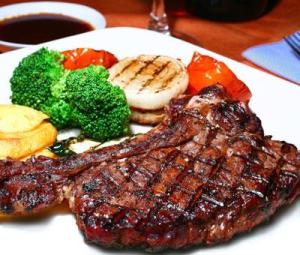-
GMOs are evil
GMOs are a valuable technology used in science, medicine, and agriculture. Farmers use them to increase yields, reduce inputs, improve the soil, and provide resistance to drought, insects and weeds. There are GMOs being used all throughout society, and there is a very good chance you’ve consumed or used a GM product today. We do believe people should be free to avoid GMOs if they want to, but GMOs have been around for 2 decades (over a trillion meals consumed) without a single sickness or health issue resulting from consumption. We’ve written about why farmers use GMOs and their many misconceptions here: What the Peterson Farm Bros Think About GMOs
-
Monsanto is evil
One of the biggest misconceptions about agriculture (or on the internet really) is that Monsanto is an evil company bent on poisoning humanity. Anyone who is familiar with Monsanto or who knows a Monsanto employee knows this isn’t true. Most of what you hear online about Monsanto is either greatly exaggerated or simply not true. We don’t believe Monsanto is perfect and we know that many people are frustrated with how much money they make compared to farmers. However, if Monsanto was truly evil, farmers wouldn’t buy their products and their employees would not enjoy working for them. Plus, they are actually doing a lot of good things! We address 15 myths we’ve discovered about Monsanto here: 15 Myths About Monsanto
-
Organic farming is the only sustainable way to farm
We are advocates for diversity in farming. We are believers in organic farming and think all of agriculture can learn a lot from what organic farmers do, but we also believe that farming is not a “one size/type fits all” industry. Our world is a complex, diverse place that faces complex, diverse problems that require complex, diverse solutions! We need big farms, small farms, conventional farms, organic farms, GMO/non-GMO, etc. in order to find those solutions and meet the needs of 9 billion people by 2050! Please watch: Greg’s Ted Talk for more on this subject!
-
Organic food is always safer, healthier, more environmentally friendly and is not grown using pesticides
Again, we are believers in both organic farming AND organic food! We do believe that if people want to buy food that has been raised organically, farmers should be allowed to meet that need. However, we don’t believe that organic food is ALWAYS safer, healthier, and more environmentally friendly. Many people buy organic food to support small farms, get healthier and safer food, and protect the environment. We believe that you can do these things without necessarily purchasing organic food. Plus, one of the biggest myths out there is that organic farmers do not use pesticides. They do. There is just a great amount of misleading information being put out there about the difference between conventional and organic food. You can read our entire opinion of organic food here: Conventional AND Organic
-
Misleading Labels
- “Raised Without Antibiotics:” Antibiotics and vaccines are used throughout the livestock industry to prevent animals from getting sick and help the ones who do get sick recover. Not using antibiotics on an animal who gets sick increases the suffering of the animal and is inhumane. Animals are never “pumped full” of antibiotics. Antibiotics and vaccines are very expensive and farmers would be stupid to overuse either one. All milk and meat is antibiotic free. There are strict withdrawal times for both that prevent antibiotics from reaching the food supply. (Read our entire opinion of antibiotics here)
- “Hormone Free:” All humans and animals have naturally occurring hormones in them, so meat and milk from animals will never be “hormone free,” but hormones can be added to an animal in production. All pork and poultry products are free of added hormones! Cattle that do receive hormones receive a tiny implant (size of a tic tac) that increases the efficiency of how they grow, it does not “fill the beef full of hormones” but adds a minuscule amount (Read our entire opinion of hormones here)
- “Non-GMO:” A non-GMO label makes sense for products that have the capability of being GMO, but many non-GMO labels are on products that are never GMO. The only GMO crops being grown are corn, soybeans, cotton, potatoes, sugar beets, papayas, canola, squash, and alfalfa. A “non-GMO” label on foods other than these creates fear that the opposite (GMO) exists in that type of food. We do believe in freedom of choice for consumers and so we aren’t anti-labeling, however, we do believe any sort of non-GMO label can cause confusion in uninformed consumers, making them believe GMOs must be dangerous, an opinion that we’ve attempted to debunk in our GMO blog.
- “Gluten Free:” Gluten free labels are great and are needed for people who legitimately suffer from gluten intolerance. However, if you do not legitimately suffer from gluten intolerance, there is no need for you to avoid gluten. Gluten has been consumed for thousands of years and is in many products that accompany healthy diets. The gluten-free fad has been beneficial in providing new products for people who are actually gluten intolerant, but is causing problems as well.
- “Grass-Fed:” The grass fed label on beef can be very misleading. All cattle are fed grass throughout their lives. Even grain-finished cattle are raised on grass for the first half of their lives. From there they are transitioned onto a grass/forage/grain diet and eventually finished on mostly grain for the last portion of their lives. “Grass-Finished” is the appropriate label and refers to the ending period of cattle’s lives when they are being finished. We believe both grass finished and grain finished are sustainable ways to produce beef. Learn more here: Why do we have feedlots and grain-finished beef?
-
Our food supply is poisoned by agricultural practices
Farmers are not poisoning the food supply. It makes zero sense that we would produce dangerous products that we ourselves consume! A vast majority of farmers use technology like GMOs, pesticides, hormones, antibiotics, etc. If you believe that these things are killing us, you must also believe that the thousands of farm families like us are willingly producing this poison! We would never do such a thing! If the farm families who used these types of technology knew they were dangerous or poisonous in any way, we would stop growing them and stop consuming them. We haven’t.
Most of the unhealthy products you consume come from the middle steps between the farmer and your plate. Evidence shows that added sugar, added fat, and added preservatives are causing health concerns rather than GMOs, pesticides, hormones, and antibiotics. These are being added by profit-hungry companies, that are agreeably hard to trust. However, at the beginning of the equation are farmers, and farm families that are creating healthy products you CAN trust! Evidence is clear that limiting calories, avoiding added sugar, fat, and preservatives and exercising daily are what is best for your health. There is no evidence that technologies used in agriculture are bad for your health.
-
Agriculture is destroying the planet
There is no way that farmers and the agricultural industry can feed and clothe billions of people efficiently without making a huge impact on the environment. However, farmers are making a lot of progress in minimizing that impact! It takes less input to grow beef, pork, poultry, and crops than it ever has, thanks to the technology we talk about on this page. Conservational farming, waste regulation, reduced emissions on machinery, and better management practices are all ways farmers are reducing their impact. We still have a lot of ways to improve, but you can’t say we aren’t trying! You can read more about how farmers are reducing their impacts on our blogs: Reducing Impact
-
Family farming is dead and corporations rule
96 percent of the farms in America are family farms like ours, according to the USDA. The vast majority of the food being produced in America is being produced by family farms. Corporations do play a big part in the industry, but they do not “control” or “rule” the food supply. Farmers are still at the root of the food equation, and are growing healthy, nutritious crops better than they ever have! Technology, efficiency, and commodity prices have definitely increased the size of these family farms, and many of them farm thousands of acres and thousands of animals, but they are still the same value-driven family farms that were around 50-100 years ago! Read more in our blog: Family Farming
-
Farmers are only in it for profit
Profit is definitely one of the central motivators in how a farmer farms. A farm would not work and a farmer couldn’t support their family if the farm was not making money. Money factors into most decisions made on a farm. However, there is so much more to farming than how much money is being made. Farmers have a rough job, one that requires many hours of hard work in tough conditions. The bottom line is that the vast majority of farmers farm because they love what they do and care about taking care of what they have and raising healthy food for people to eat, not because farming makes them rich.
-
Farmers don’t care about the land
As mentioned above, there is no way agriculture can feed and clothe billions of people without making an impact on the environment. However, farmers do care greatly about their land, their water, and the environment! It only makes sense. Why would farmers abuse the land that produces the crops they make a living with? Why would farmers pollute the water that their family drinks and that they need to grow their crops? Why would farmers destroy the environment that they live, breathe, and work in every day? Farmers are the original stewards of the earth and to this day are working hard to improve the health of the soil, the water, and the air.
-
Farmers don’t care about their animals
Again, why would farmers mistreat the animals that they are raising for a living? Animals that are mistreated do not grow as fast or as healthy as animals who are treated right. It is every advantage to a farmer to give an animal the food, shelter, medicine and quality of life it needs to be happy. If not, the animal will get sick or not produce well and the farmer will lose money. Furthermore, farmers love their animals. If they didn’t they wouldn’t raise them. It takes a lot of work to raise animals and it requires many sacrifices. Livestock live better lives than many humans do! Please read our “Animal Welfare” blogs for more.
-
Farmers drench their crops in pesticides
When people think about farmers using pesticides in crop production, they typically think of a crop being drenched in toxic pesticides. In reality, up to 95% of a spray mixture a farmer uses is water, and very little of the spray is actually applied to a crop. It is common for only a soda can’s worth of pesticide to be sprayed on an entire acre (football field). Most pesticides are sprayed before and after a crop is planted, but even for pesticides applied during the growing season, residues from such mixes are always given time to wear off of a plant before harvest, especially in cereal crops. The amount of residue in your food is far, far below anything that would ever affect you. However, you should always wash fruits and vegetables before eating. You can read more about toxicity levels and pesticides on our blog: Chemical Application in Agriculture
-
Farmers don’t rotate crops
A common criticism of farmers is that they practice “monocropping,” aka they don’t rotate their crops. As of 2017, nearly all farmers rotate their crops in some way, organic farmers or not. Some may only rotate between 2-3 crops (corn, soybeans, wheat) or some, like ours, may rotate between 5 or 6. The other definition of “monocropping” is planting just one crop in a field. Planting multiple crops at once is an impractical goal for farmers as they cannot harvest the crops in an efficient way. However, many farmers today are implementing “cover crops” that allow for multiple crops to be grown in a field in one growing season. It is common knowledge that rotating different crops in your fields creates better soil health and higher yields. Soil health is becoming more and more a part of the farming discussion and a great amount of research is being done on how to build the health of soil. (Read more: How are farmers improving?)
-
Farmers get rich off of subsidies
Subsidies exist to help farmers supplement their income, manage their expenses, and maintain the supply of agricultural commodities. While the system isn’t perfect and it does tend to favor large farmers over smaller ones (we agree it should be opposite), subsidies are a valuable part of the farm economy. Many subsidies come in the form of crop insurance, where a farmer is reimbursed if their crop fails. Without this system in place, more farmers would go broke and there would be even fewer farms operated on an even larger scale. There would also be a higher risk of financial crisis in lending institutions. The vast majority of farmers do not get wealthy off of farm subsidies, they just provide a slight cushion of constant in a profession that is very vulnerable to volatility. (Read more: Crop Insurance in America)
-
Large scale animal agriculture (factory farming) is evil
One of the practices that gets the biggest knock in agriculture is intensive animal farming or “factory farms.” Factory farms are by definition farms that have thousands of animals. Our farm is a “factory farm.” Without intensive livestock farming, there would simply not be enough meat, dairy, eggs and animal products to go around. It is the most efficient way to raise animals, because the animals are all in one spot and the farmer can take care of them easier. Economy of scale, when done right, can often lead to better care of animals and less input required to raise one. The important thing to remember is that smaller is not always “better” and bigger is not always “right.” It all depends on the location, type, and climate of the farm and the commitment of the farmer to the animals. (Read more: What are factory farms? and The Welfare of Livestock Animals)
-
Meat, eggs, and dairy are unhealthy for you and the environment
People have been eating meat, eggs, and dairy products for thousands of years. Many of the people who live to be very old have eaten diets containing these for their entire lives. Meat, eggs, and dairy are excellent sources of protein and nutrients and build strong muscles and bones. Should you over-consume these products? No, just as with anything. The environmental impact of raising this type of food is also greatly overstated. While raising animal products does take it’s toll on the environment, they are the best, most efficient way of delivering protein to a hungry world. And farmers are working hard to minimize their impact each day. For more on our opinion of this subject, please read our blog: Why We Raise Animals For Food and Products
-
Everyone should be vegan
While we do respect the vegan and vegetarian lifestyle, we feel very strongly that not everyone needs to avoid meat and animal products. These products are very valuable to our infrastructure, efficiency, economy, and accessibility to protein. A vegan lifestyle is simply not possible for everyone. Vegans also advocate that animals who are raised for food an products are abused, exploited, and made into slaves. We do not feel this to be true at all and explain why in our blog: Why We Raise Animals for Food and Products
Are cattle bad for the environment?
AVOIDING BEEF IS NOT THE SOLUTION TO REDUCING GREENHOUSE GAS EMISSIONS!
➡️Transportation, industry, and energy are approximately 80 percent of United States ghg emissions. (Source: EPA)
➡️ Agricultural emissions are only 9 percent of the United States ghg emissions. (Source: EPA)
➡️ Of that 9 percent, only 2.6 percent is from cattle. (Source: EPA)
➡️ The benefits cattle bring to the environment counteract most, if not all, of the greenhouse gas they emit. Cattle and agriculture as a whole have the potential to be a net positive in terms of ghg through carbon sequestration! It makes no sense to get rid of them or stop eating beef…it does make sense to improve how we raise them! (Which we are doing!)
➡️ Cattle upcycle grass that grows on soil that can’t grow human food to high quality protein that humans can consume. This is one of the most efficient parts of U.S. agriculture. This is also why the U.S. is blessed to have the greatest ease of access to low cost protein in the world.
➡️ Cattle utilize food and feed products that would normally be wasted and turn them into high quality food and products.
➡️ Cattle provide manure that fertilizes the soil naturally and leads to healthier soil (higher organic matter) and better yielding crops.
➡️ Cattle manage millions of acres of grasslands and prairie in this country. Hundreds of years ago there were millions of buffalo doing the same thing. Cattle are part of the natural ecosystem and are vital to manage it.
➡️ Cattle give us hundreds of by-products along with the food they provide us to eat. https://bit.ly/2NBUylo
➡️ Cutting back our transportation or energy emissions 10 percent would have FIVE TIMES the impact of eliminating meat from everyone’s diet!
FURTHERMORE…
➡️ Cattle provide diversified income to family farms and provide work for farmers in the winter when crops are not growing.
➡️A small cow herd is what gives most young farmers and ranchers their start. Without this option, the trend of larger farms and older farmers will continue but at a faster rate. Currently there are 915,000 cattle farms and ranches. 91% of those are ran by families. 11% are ran by women. (Source: NCBA) The average age of operator is 57 and we need that to go down not up!
➡️Kids who grow up on farms around livestock or raise a few head of cattle for 4-H or their county fair learn valuable lessons that cannot be taught in the classroom. It is the best way to grow up and farm kids wouldn’t trade it for anything.
➡️ MEAT IS NOT MURDER. Every time you eat meat, you have given an animal a life, and a very good life at that, despite what many activists will claim. If we eliminated meat from our diets, billions of animals would never have a life. Read more of why we should eat meat on our blog: https://petersonfarmblog.wordpress.com/…/why-do-we-raise-a…/
➡️Animals on farms are not tortured, abused, enslaved, etc except in rare cases by sick people. Read more on the true state of animal welfare on our blog: https://petersonfarmblog.wordpress.com/…/the-welfare-of-li…/
FURTHERMORE…
➡️ The world population is expected to grow from 7 billion people to 9 billion people in 2050. Most of this growth will be in Asia. The effect of eliminating beef from diets in Europe and North America (Where it is being pushed the hardest) is DWARFED by the increase of emissions the additional population in these countries will create if their ghg emissions are not improved.
➡️ It does not take a genius to figure out that large cities emit more ghg and pollution than cattle farms do. The air quality, water quality, soil quality, and environmental health surrounding cities is terrible compared to what surrounds cattle farms. Especially in other parts of the world (Africa, Asia, etc.) There should be much more of a push to clean up emissions from cities (Transportation and Energy) than farms.
➡️ The U.S. beef industry has greatly reduced it’s environmental impact per head over the last few decades. It’s how we produce 25% of the world’s beef with only 10% of the world’s cattle. We’re not perfect, but agriculture has actually done a great job as a whole reducing it’s environmental impact.
➡️There will be many comments in response to this post saying that what needs to be cut out the most is “factory farms” aka large intensive livestock farms. These farms are greatly misunderstood and I will have a separate post in response to these comments: (Link coming soon)
Essentially, large livestock farms are what make the beef cattle industry as efficient as it is. Large livestock farms are still ran mostly by families. One family can easily manage thousands of head of livestock. The same reason we have large livestock farms is the same reason we have large cities. If you believe we should not have large livestock farms, you should also believe we should not have cities. The size of the farm does not determine the welfare of the animals nor the effect on the environment. Use of technology such as confinement, hormones, antibiotics, GMOs, etc. is all designed for the welfare and to the benefit of the animal. We have blogs on all of these here: https://petersonfarmblog.wordpress.com
Some final thoughts to chew on:
➡️ 50% of the food we produce in this country is wasted. If we cut that in half it would have a much greater impact than not eating beef.
➡️ There are 9.2 million horses in America and over 100 million pets (cats and dogs). Yet, no one ever suggests reducing those numbers…
➡️ All human activity greatly impacts the environment. If we approached humans the same way we approach beef cattle in terms of ghg, all humans would need to be eliminated. It makes much more sense to continue to improve something rather than eliminate it.
➡️ Celebrities, politicians, and media groups advocating for the abandonment of meat abuse transportation emissions, eat food that is transported in from other states/countries and throw over half of it away, own multiple/huge homes that require lots of energy to build and maintain, and lead completely inefficient and ghg-emitting lives. Yet they want you to stop eating something you enjoy (beef) and they want farmers to abandon a large part of their operation.
THE BOTTOM LINE: Eliminating meat from your diet (and eliminating cattle) would have a minimal effect on ghg emissions, but would have a DISASTROUS effect on agriculture, farmers, the soil, the environment, western culture, ease of access to protein, and good tasting food.
WE IN THE USA NEED TO FOCUS ON THE 80 PERCENT! NOT THE 2 PERCENT! Reduce transportation and energy, not the industry that feeds you. And worldwide, we need to get Asia, Africa, and South America to get on board with reducing emissions or anything reduced in Europe and North America with be completely ruled out by increases there.
CATTLE AND AGRICULTURE ARE THE SOLUTION, NOT THE PROBLEM! 🚜🐂
Innovations in Agriculture
This blog is sponsored by AGCO; however, all thoughts and opinions expressed are my own.
I’ve been involved in farming my entire life. I was the first of the Peterson Farm Brothers to enter into the world, and my mom had me riding along in the silage truck in my car seat when I was just a few months old! I am part of the 5th generation of our farm. This means my dad worked on this farm as well as my grandfather, great grandfather, and great, great grandfather. You can see pictures of each generation in our video “Our Farm Song” on YouTube.
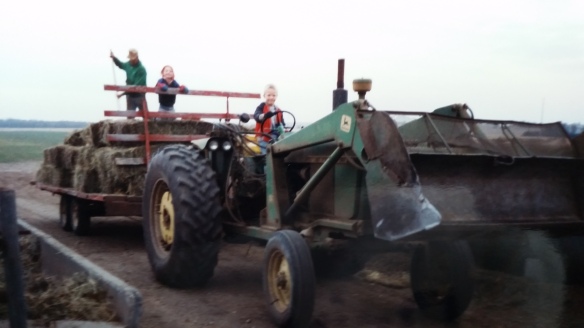
That’s me (Greg) on the tractor!
As you can see, our farm has changed a lot over the last 100+ years! Our farm was started in the late 1800s by Louis and Jenny Peterson. Back then, things were pretty tough. Everything was done by hand or using horses. We had a lot of chickens and cattle. The next generation was Elof and Hulda Peterson. They faced the hardship of some of the men in the family having to leave the farm after getting drafted for the war. My grandpa Norris was the youngest brother and was allowed to stay home to take care of the farm and his mother when he was only a teenager. During that time our farm struggled through the Great Depression, barely providing enough for the family to get by. Farming was hard. Then my grandpa then married my grandma Eunice and over the next 50 years expanded our farm. He was able to do this through the technology that became available in agriculture. Below is one of the first tractors we used on our farm. It was bought in 1941! This was cutting edge innovation at the time and greatly increased productivity on our farm.
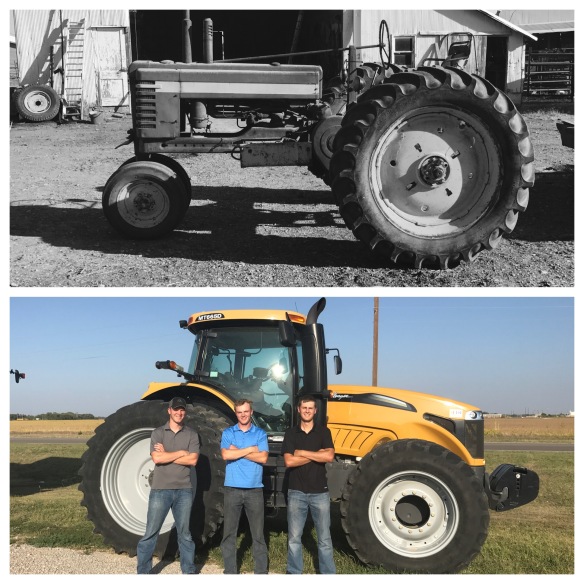
The second picture is of my brothers and I standing in front of a modern day AGCO Challenger tractor. Technology sure has changed! The first tractor our farm bought required the farmer to spend hours out in the heat, wind, and dust each day. It took 10 times as long to get a field tilled or planted. There was danger of the tractor flipping over and crushing the farmer. While it was an amazing piece of technology at the time, it is nothing like the tractors of today.
The AGCO tractor pictured above is truly innovative. AGCO designs their tractors to be extremely powerful yet use fuel very efficiently, minimize compaction to fields, control inputs through precision farming, and steer perfectly straight through the field using GPS guidance. We got to test drive this tractor and were amazed at how much technology was in the cab. Tractors now have many safety requirements such as a rollover protection system that is built into the cab. The cab was also incredibly comfortable, with climate control, premium audio, and leather seats. So much nicer than tractors of the past!
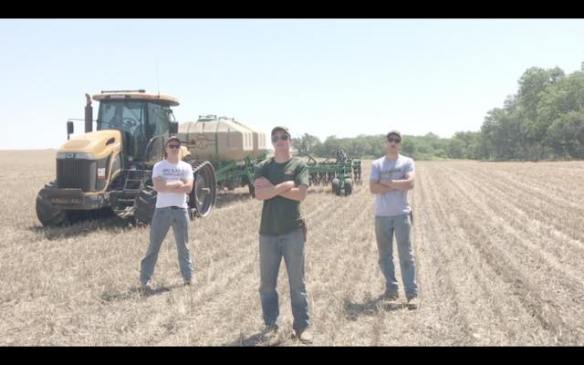
Our AGCO Challenger tractor is featured in our parody “Residue.”
All the equipment in farming has gotten larger, more efficient, and more environmentally friendly. AGCO focuses on improving uptime, machine optimization, logistics management, and reduced waste. Check out AGCO’s website to see all the different equipment they manufacture (Challenger®, Fendt®, GSI®, Massey Ferguson®, Valtra®, Gleaner, Sunflower, White Planter, RoGator and TerraGator). They deliver innovative agricultural solutions through a full line of tractors, combine harvesters, hay and forage equipment, seeding and tillage implements, grain storage and protein production systems, as well as replacement parts.
Today our family farm consists of my brothers, Nathan and Kendal, my sister Laura, and my parents David and Marla. We, along with most farmers, utilize much of the technology that is out there in agriculture. We don’t have the newest tractors and equipment, but it is really interesting to see what all is being developed. Modern day farmers like my family and agribusinesses like AGCO are engineers, botanists, biologists, economists, and entrepreneurs. Together we are tasked with ensuring global food security, which occurs when all people have access to sufficient, safe, nutritious food to maintain a healthy and active life. Being part of the agricultural community that is working to reach that goal is amazing! As farmers, we try to increase yields while conserving inputs and being better stewards of land, animals, and the environment.
AGCO helps give farmers the tools and technology they need to accomplish this. They are also working hard as a company to ensure global food security. Learn more about what they are doing here. Sometimes as farmers and equipment manufacturers these goals can be overwhelming. It is a lot to take on, but we are all up for the challenge!
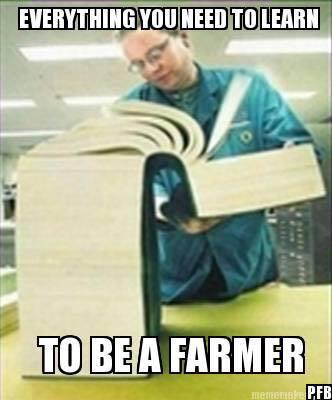
Our farm and the technology in agriculture has changed a lot over the years, but the concept of working with my family has not. We hope to keep our farm going for many generations to come. We will do that through innovation, just like we’ve always done. Who knows what farming will look like 100 years from now? Working with your family has its ups and downs, but I wouldn’t want to be anywhere else.
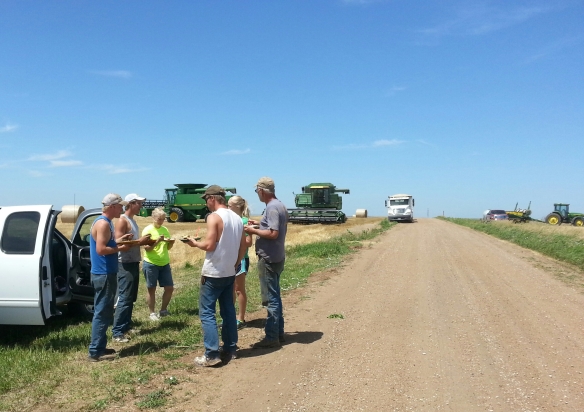
Antibiotics
It is no secret that many people are concerned about the use of antibiotics in our food production. Often people will try to avoid consuming them by purchasing food with “raised without antibiotics” labels. Is it worth paying extra for these labels? Are there really antibiotics in our food? Is overuse of antibiotics an issue? This blog will try to address those questions!
Are there antibiotics in my meat and milk? The answer to this questions is NO! It is illegal for meat or milk to contain any antibiotics. While antibiotics can be administered to animals being raised for food, the FDA requires all meat and milk to be antibiotic free when sold for consumption. This is done by requiring a very strict withdrawal time before meat can be harvested (slaughter) or milk can be collected from an animal that has been given antibiotics.
This is especially true in milk. When a dairy farmer has to give a sick cow antibiotics, the dairy farmer must dump the milk from that cow down the drain for a select number of days until the antibiotics inside the cow are through its system. Milk is tested before it is taken from the farmer and if any antibiotics are found in the milk, the whole load must be dumped down the drain. (Click here to learn more here)
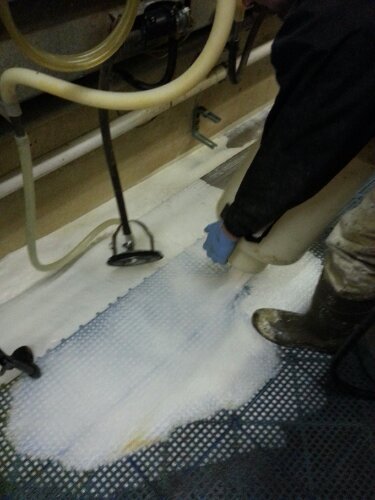
The lesson to be learned is that by the time you eat milk or meat, any residues of antibiotics that may or may not have been there will be long gone! Farmers are lawfully bound to this practice.
How are antibiotics used in the livestock industry? Antibiotics and vaccines are used throughout the livestock industry to prevent animals from getting sick (preventative) and help the ones who do get sick recover (therapeutic) and to promote healthy growth (sub-therapeutic).
Therapeutic: Licensed veterinarians give farmers recommendations on what to give sick animals. Not using antibiotics on an animal that gets sick increases the suffering of the animal and is inhumane. Animals are never “pumped full” of antibiotics. Only a few milliliters (5-10) are given to each animal, which is less in comparison to that of humans in relation to overall body weight. A single bottle of antibiotics can cost hundreds or even thousands of dollars (the bottle of Draxxin pictured below was around $2,000) and a livestock farmer would be stupid to use more than he has to. A single bottle can doctor up to 100 animals.
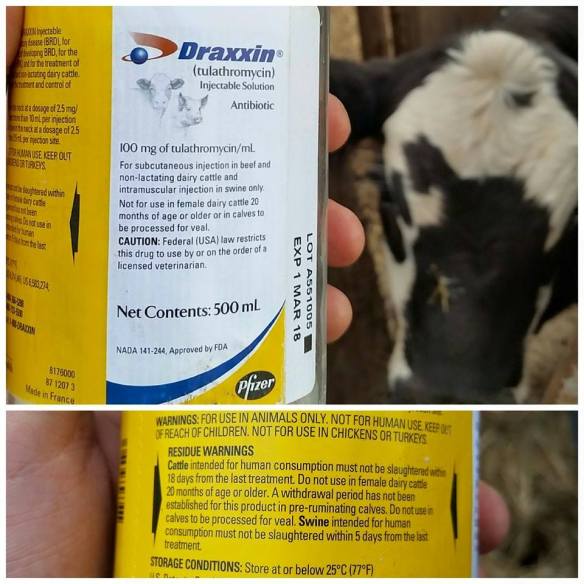
Preventative and Sub-Therapeutic: Cattle are sometimes vaccinated when moved to a new place in order to prevent sickness. Cattle can also in certain situations be given feed additives. Our friend Ryan Goodman does a great job of describing those here: Feed Additives and Ionophores
Antimicrobials and sub-therapeutic antibiotics are used throughout the poultry and swine industries. These are low dose antibiotics given through feed that improve growth efficiency, prevent illness, and even prevent food-borne illnesses.
In all of these cases, doses are given at incredibly low amounts. However, there is room for concern with these practices, and farmers and scientists alike are looking for answers and solutions.
Is antibiotic use in animals causing resistance in humans? Most antibiotic use in livestock farming deals with different antibiotics than what are used in humans. However, antibiotic resistance is developing in both humans and animals. In both cases, overprescribing antibiotics is contributing to the issue. Farmers, veterinarians, and human doctors should be aware of this issue and be working to find solutions and using antibiotics in a responsible manner. (Read more here)
If some farms can raise animals without using antibiotics, why can’t all? The “raised without antibiotics” label is somewhat misleading. Even on farms that attempt to raise animals without antibiotics, animals get sick. Just like humans, certain animals are more prone to sickness than others. Antibiotics are still given to animals on these farms, but are pulled from the “raised without antibiotics” herd and sold as conventional meat or dairy. At this point, there is no way all of our animals can be raised without antibiotics. At best, “raised without antibiotics” is a specialty product for now. In order to raise enough animals to meet consumer demand, antibiotics must be used to keep animals healthy.
Hormones
It is no secret that many people are concerned about the use of hormones in our food production. Often people will try to avoid consuming them by purchasing food with “hormone free” labels. Is it worth paying extra for these labels? Are there really hormones in our food? This blog will try to address those questions!
Are there hormones in my meat and milk? Meat and milk (and most food including plants) are never “hormone free.” All humans and animals (Cattle, Pigs, Chickens, Turkeys, etc.) produce hormones naturally. There will always be hormones in the food you eat and in your body.
Hormones can be given to animals in certain types of livestock production which we will explain below. If food has been raised without any added hormones in production, the correct label should be “no hormones added.” A “hormone free” label is wrong and misleading.
However, the thing to remember is that hormones (whether natural or added) are not dangerous to consume at the levels found in your food. We will explain that below.
Are added hormones used in livestock production?
- Hormones are never added or used to raise pork and poultry products! It is illegal to add hormones in pork and poultry production and a label stating no hormones or no hormones added on pork or poultry products is meaningless. You do not have to worry about hormones at all with pork and poultry. The reason pigs and chickens are so much bigger and grow so much faster all has to do with breeding techniques. Learn more here: Why Do Chickens Grow So Large So Quickly?
- Hormones can be used in beef and dairy production.
How do hormones work in beef and dairy? Hormones are given in a form of an “implant” to beef and dairy cattle. In beef, hormones such as estrogens or androgens are often administered to growing cattle to promote growth by complementing the effects of naturally occurring hormones. (Learn more at: Igrow) In dairy, the most common hormone used is rBGH. Hormones improve the efficiency of an animal to grow or produce milk and using them can help improve sustainability because it takes less water, feed, land, and time to raise the same amount of food.
How much hormones are added in beef and dairy production? The amount of hormones given to these animals is incredibly small. Below is an example of an implant administered to beef cattle to help them grow efficiently. It is the size of a tic tac (picture below).
(Photo from Ryan Goodman)
Will the added hormones in beef and dairy affect my health?
Beef: A common myth surrounding beef produced with additional hormones is that it is unsafe to consume. The fact is that the U.S. Food and Drug Administration regulates the development and use of hormone implants and the Food Safety Inspection Service of the USDA routinely monitors residues of synthetic hormones in meat. It is true that beef from hormone-implanted cattle has increased estrogenic activity compared with non-implanted beef. This fact alone may alarm beef consumers but it must be put into the context of actual amount consumed and the levels found in other products. As shown in Table 1., beef from a non-implanted steer contains .85 units of estrogenic activity per 3 oz. serving, while beef from an implanted steer contains 1.2 units of estrogenic activity in the same serving. However, this amount is a fraction of what is found in many other common foods. For example the same quantity of eggs would provide 94 units of estrogenic activity and a 3 oz. serving of tofu would provide 19,306,004 units of estrogenic activity. In fact, a normal adult male produces 136,000 ng of estrogen per day while a non-pregnant women produces 513,000 ng/day on average, making consumption of the levels of estrogen in implanted beef relatively inconsequential.
Table 1. Estrogenic activity of common foods (ng/3 oz serving)1
| Food | Estrogenic Activity |
| Soy flour (defatted) | 128,423,201 |
| Tofu | 19,306,004 |
| Pinto beans | 153,087 |
| White bread | 51,029 |
| Peanuts | 17,010 |
| Eggs | 94 |
| Milk | 5.4 |
| Beef from implanted steer | 1.2 |
| Beef from non-implanted steer | .85 |
| 1Units are nanograms of estrone plus estradiol for animal products and isoflavins for plant products per 3 oz of food. | |
| Hoffman and Eversol (1986), Hartman et al. (1998), Shore and Shemesh (2003), USDA-ARS (2002). Adapted from: Loy, 2011 | |
– See more at: http://igrow.org/livestock/beef/hormones-in-beef-myth-vs.-fact/#sthash.HRt0iFvV.dpuf
For a simpler picture of hormone levels in beef, check out this picture. The added hormones in beef are a fraction of the naturally occurring hormones in other food items and humans. Whether naturally occurring or added, these levels of hormones are all safe to consume in humans! These levels are similar in milk. (More: M&Ms)
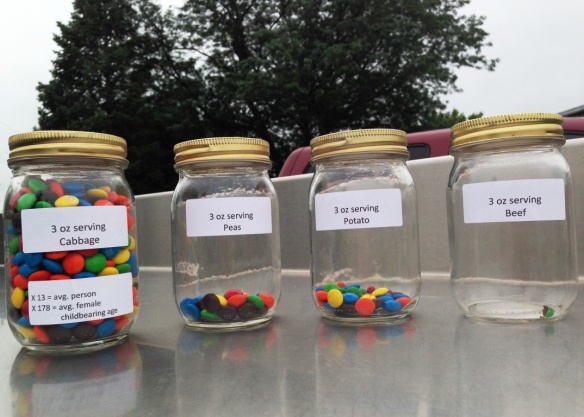
Dairy: Only 15% of dairy farmers use any sort of growth hormones in their cows. Most milk you find in the grocery store will have a “no hormones added” label. Bovine somatotropin (also called bovine growth hormone or rBGH) is perhaps the most well recognized growth hormone used on dairy farms. bST is “a protein hormone produced in the pituitary gland of animals, including humans, and is essential for normal growth, development, and health maintenance.” Very little bST is used in dairy cows and there is no test that can distinguish between cows treated with bST and naturally occurring bST (3). Humans do not have receptors for bST and therefore it is passed through your body intact without being absorbed (4). As a result, there are no known side effects or health issues associated with consuming dairy from cows treated with bST. (Source)
Here is a write-up on the differences in hormone levels in milk produced with rBST, milk produced without rBST, organic milk, and raw milk: http://igrow.org/livestock/dairy/hormones-whats-in-your-milk/
15 Myths About Monsanto
-
Anyone who supports Monsanto is a paid “shill”
Monsanto has developed a terrible reputation over the years and it is peculiar as to why that has happened. One of the reasons is because anyone that tries to defend them is labeled as a “shill.” This means the opposition believes that anyone who defends Monsanto is being paid to do so. I can assure you this is not the case. There are thousands of privately funded scientists, millions of people in agriculture, and myself who do not believe Monsanto is a terrible company and who are not getting paid to have those beliefs. The simple fact is that Monsanto, while very large, does not have nearly enough money to pay everyone who supports them, or even half of everyone who supports them. That notion is implausible and doesn’t even make sense. There has never been any evidence to show that something like this is happening. Plus, Monsanto was recently bought out by Bayer, proving again that they can and do struggle financially sometimes and have no business paying thousands of people lots of money to defend them.
(In an attempt to be as transparent as possible, my relationship with Monsanto is as follows. On our family farm, we do use Monsanto seed on a small portion of our acres and we do apply the Monsanto chemical glyphosate on our fields to control weeds. However, neither of those things are vital to our operation. Our farm does not “rely” on Monsanto in any way and could easily continue to function entirely without a buying relationship with them. Monsanto has never given our farm or my family any money to do anything on their behalf, but they did fly our family to a convention to receive an award for agricultural advocacy in 2013. However, a free flight (or any type of compensation for that matter) would never be enough for me to advocate for a company that I honestly believed was evil or bad. I do not believe Monsanto is either of those. It has always been my goal to search for and promote the truth about whatever it is I am talking about, and this blog about Monsanto is no different.)
-
Monsanto is evil
There are many out there who simply believe that today’s Monsanto is pure evil. There are conspiracy theories out there that Monsanto is trying to poison the world. This is simply not true if you examine the evidence. While Monsanto is a huge company, and that itself is reason enough for concern about who they are and what they do, most of what Monsanto does is not evil or even bad. They can be greedy, as can any huge company, but in most cases, what they are doing is by and large, good. Let’s discuss the main grievances people have with Monsanto.
-
Monsanto’s GMOs are poisonous
Most people who are anti-Monsanto are also anti-GMO. If you truly believe that GMOs are evil and are being produced to “poison the world,” it would be logical to believe that the company (companies) behind that is evil as well. However, if you examine the evidence on GMOs, it is clear that at the very least (even if you don’t support them) they are not poisonous or evil. And at the best, they are a very beneficial technology that is both feeding people and helping the environment. (Read what we believe about GMOs)
-
Monsanto’s glyphosate is poisonous
Next to GMOs, the biggest problem people have with Monsanto is their production of one of the top selling chemicals in the world, glyphosate. Many people believe glyphosate is over-applied, extremely toxic, and causes both health and environmental problems. On the contrary, glyphosate is one of the safest, least toxic chemicals used in agricultural production and is applied at extremely small amounts. Evidence is also strong that glyphosate does not cause health or environmental problems when used responsibly. (Read more about what we believe about glyphosate and other chemicals)
-
Monsanto manufactured agent orange
This is a common argument used to prove the fact that Monsanto is evil. It is slightly misleading. There are actually two “Monsanto” companies that have existed. The first one, the former Monsanto company, manufactured agent orange from 1965 to 1969 as part of a government contractor for the war. They also developed a bad reputation as a company. That chemical company was sold to Pfizer in the 1990s. The Monsanto of today is a combination of seed companies that were acquired in the 1990s and 2000s and relaunched as a separate, new “Monsanto company.” This “new Monsanto” was formed to incorporate new science and technology in the development of seed, providing farmers with the ability to create more food with less land, water, and chemicals than had been previously possible. That’s what Monsanto has been doing ever since, and has built up a very positive reputation in the agricultural community, but much of the public’s opinion of them is based on the “old Monsanto” that was a disliked chemical company. (Read more about the history of Monsanto)
-
Monsanto is a massive, controlling monopoly
Monsanto, while a large company, is not massive. They are 189th on the Fortune 500. They are worth $66 billion. Apple in comparison is worth $500 billion. Monsanto is also not a monopoly. There are many companies farmers can buy their chemicals and seed from. That being said, Monsanto does have a huge market share of seeds (25% of all seeds) and chemicals around the world and is the largest seed company. The consolidation of seed and chemical companies is real and is a cause for concern. But the reason they keep consolidating is because it is so difficult and costly to bring new GMOs and new chemicals to the market, due to so many regulations. In conclusion, you can’t say Monsanto is large and trying to consolidate without also recognizing the reason why: GMOs and pesticides are unbelievably regulated and inspected for health and safety and hardly anyone can afford to produce them.
-
Monsanto sues farmers
One of the main accusations about Monsanto is that they sue farmers. Yes, Monsanto has sued farmers before, but only because they broke the rules of the technology agreement Monsanto requires with a purchase of their seed. Just like any invention, Monsanto’s GMO seeds are patented to make sure people are not stealing from them. By signing the agreement, the farmer agrees to buy new seeds from Monsanto each year. The farmer is not forced to do this, they are free to buy non-GMO seeds from somewhere else. To be clear, Monsanto rarely sues farmers (only 8 times per year since 1998, out of thousands of seed transactions each year) If a farmer follows the rules of Monsanto’s technology agreement (don’t replant the seeds), they have nothing to worry about. Most farmers do not save seeds anymore anyway, for a variety of reasons. Monsanto does not sue for inadvertent (accidental) contamination or from cross pollination. A farmer has to willingly, knowingly break the rules in order to be sued and could easily eliminate the risk of being sued by never buying from Monsanto in the first place.
-
Monsanto is causing farmers to commit suicide
A widely publicized rumor several years back was that farmers in India were committing suicide after trying to plant Monsanto’s GMO seeds. It is true (and extremely sad) that 270,000 farmers have committed suicide in India over the last several decades. Monsanto, however, has never had anything to do with this, and has actually helped millions of Indian farmers with their technology. Over 90% of Indian cotton farmers now use GMO seeds. Why would the technology spread so successfully if it was making farmers commit suicide? There are many reasons Indian farmers have taken their own lives over the years, including crop failure from weather events, banking policies, cultural shame, and just an overall suicide problem in the country (over half of all suicides come from India and China). The issue is outlined in this write-up: Why are Indian farmers committing suicide?
-
Monsanto is bad for farmers and rural communities
There is a general feeling on the internet of “poor farmers being under Monsanto’s control.” In reality, nearly every farmer you talk to recognizes that Monsanto is just another big agricultural company who they can *choose* to buy seeds or chemicals from. There will definitely be some farmers that don’t like Monsanto, simply because they make a lot of money and charge a lot for their products, but farmers continue to buy Monsanto products because they are the best option for their farm, not because they are being forced to in any way. Monsanto is also one of the greatest contributors and donators to rural communities in America and around the world. They are constantly sponsoring youth programs, funding local research, and giving back to many non-profit organizations. Read more here: Monsanto Giving
-
Monsanto creates seeds that are sterile (terminator seeds)
Terminator seeds (seeds that become sterile after one year) were a concept developed by Monsanto early on the history of GMOs, but they received so much public backlash that Monsanto never brought them to market. Monsanto’s GMO seeds can be planted again the next year and they will grow, it’s just against the rules to do that. There are no terminator seeds available today nor were there ever any brought into commercialized production.
-
Monsanto hates bees
Many people hold the belief that pesticides and GMOs are responsible for bee population decline. We address that myth in our GMO and Chemical blogs. If you can get look past that misguided belief and examine the actual evidence, you will find that many different factors are contributing to bee decline and most of them are not related to Monsanto. Monsanto is actually working hard to find a solution to bee decline (Read more here).
-
Monsanto employees are all terrible people
Many people believe that all Monsanto employees must be terrible people and hate their jobs. Anyone who knows a Monsanto employee, however, knows this is not even close to true. Monsanto was voted the 59th best company to work for in the world. They are well respected in the agricultural community and the employees who work there are some of the nicest people you’ll meet. I had many friends in college take internships with Monsanto and/or went on to work for Monsanto and I never once heard them badmouth the company. (Read more about Monsanto employees and how they feel about working for Monsanto)
-
Monsanto employees don’t eat food containing GMOs
This myth is simply untrue and never had any grounds of being true. Monsanto has never excluded GMOs from their cafeterias nor do their employees avoid GMOs in their personal grocery shopping. (Read more)
-
Monsanto only sells GMOs
Monsanto sells many different seeds besides GMOs. This includes non-GMO seeds, organic seeds, and vegetable seeds. They also sell a variety of chemicals and weed control products.
-
Monsanto is against labeling GMOs
Monsanto has a very similar opinion to us of GMO labeling. Click here to read Monsanto’s opinion of labeling GMO products. Click here to read our opinion of GMO labeling.
Conventional *AND* Organic (Celebrating Diversity in Agriculture)
Hello everyone, welcome to my blog about conventional and organic food.
The video below is of a TEDx talk that I gave in February of 2016. The theme of the TED event was “Fueling Human Existence” and the title of my talk was “Celebrating Diversity in Agriculture.” There are some missing powerpoint slides in the YouTube video, so I included a summary below to help make sense of parts of what I say. This video will serve as an introduction to my thoughts on conventional and organic (found below the summary of the TED talk). Thanks for watching and reading!
Summary:
–Agriculture fuels human existence. Without agriculture, we could not survive.
–The story of agriculture is that of diversity. There are millions of farmers all over the world growing an incredibly diverse amount of crops, plants, and animals in all sorts of climates, soils, and cultures. These farms can be large, small, conventional, organic, etc.
–One farm is not like another. Just because one farm does something one way, does not mean that all farms do it that way or need to do it that way. It all depends on what is best for a particular farm in that particular location.
–Farmers are experts in their particular field. Most have been trained since they were children in how to farm. Colleges, universities, and agricultural organizations offer tremendous amounts of research and conventions, workshops, and expos to help farmers farm as efficiently and sustainably as possible. However, an expert in one type of farming isn’t always an expert in another type of farming.
–Family farm operations still make up the vast majority of farms in the U.S. and around the world. While large agricultural corporations and business are a big part of food production, family farmers are at the root of the equation, and are made up of some of the most honest, value-driven, hard working people you will ever meet. We should be able to trust these families.
–Technologies like GMOs, Pesticides, No-Till/Cover Crops, Precision Farming, Intensive Livestock Farming, and Organic Farming are all valuable tools that can help us solve some of the problems we have in the world today. However, they are often met with skepticism, criticism, and resistance both from people and from other farmers. Many of these criticisms are misguided. (Please read the blog below for more on this!)
-We do need to question new technology and keep people, government, and corporations in check, but we need to stop the fighting between farmers and misguided attacks on different types of farming practices.
-Instead of fighting to get rid of each other’s farming practices, we should be fighting to change the real problems we face: 1) Difficulty of Farming 2) Hunger 3) Waste 4) Environmental Impact
–We need to support and improve all methods of agriculture! (Conventional, Organic, Urban, Vertical, Greenhouse, etc.) If we took all the time, money, and effort spent debating which method of farming is better and invested it into making each method better, we would make a lot more progress in fighting the real problems we face.
–We live in a diverse world with diverse types of people and we need diverse types of farming. It doesn’t make sense to limit farming to one type of practice (Ex. conventional OR organic). To exclude or alienate the others. One type of farmer can’t feed the world. One type of crop can’t feed the world. Just as it is better for a farmer to rotate between several different crops instead of planting one crop over and over again, it is better for agriculture to utilize all of its methods instead of just one. Diversity is the answer.
–Be thankful for the remarkable food system we have.
–Make sure to get information about your food from experts, not random people who post online. An expert in organic farming would be an organic farmer, an expert in conventional farming would be a conventional farmer. An expert in biotechnology would be a geneticist, an expert in pesticides would be a chemist. And so on and so forth.
-Fighting, conflict, accusations, fear, propaganda, and misinformation are not what will fuel human existence in the future. Human existence will be fueled by supporting one another and working together to find diverse solutions for diverse methods of food production in a diverse world.
My Opinion of Conventional and Organic
The conversation about food these days is filled with misconstrued, biased, agenda-driven information. While I don’t think my opinion is perfect or 100% right, I have tried to form it in a way that is as accurate and fact driven as possible. You don’t have to agree with all I have to say! Please feel free to leave a polite, respectful comment below.
From what I’ve heard in person and seen on the internet, the general opinions people have of organic and conventional food seem to fit in one of the following categories (paraphrased).
- I buy whatever is the cheapest or best tasting and don’t really know or care about the difference between organic and conventional.
- I buy only organic (or non-GMO, dairy free, vegan, cage-free, free range, etc.) because the alternative (conventional) is filled with toxic things that might kill me like pesticides and GMOs. I buy organic to support the small farmers and not support Big Ag Corporations. Conventional farmers use terrible practices that harm the environment and abuse animals but organic farmers are held to a higher standard and aren’t hurting the environment or animals. I just want farming and food to be like it used to be for my grandparents.
- I never buy organic because it is a waste of money. Organic marketing is a scam. Organic farming can’t feed the world. Organic farmers are just taking advantage of higher premiums. They don’t produce as much per acre and their crops often fail.
ALL THREE OF THESE OPINIONS ARE MISGUIDED!!! While there is a bit of truth in each one, all three of these have many misconceptions and inaccurate statements. I will try to address each of these.
Let’s start really quick with #1. I understand the idea of purchasing the cheapest food you can as I know many people must spend as little as they can to fit their budget. However, you should care about your food! Don’t be a lazy consumer. Learn about where and how each type of food is grown and the people who grow it. Learn about nutrition from credible sources. Farmers are always happy to explain why they do what they do and many will even offer tours of their farm! Don’t just rely on marketing schemes to determine your buying choices. Visit farms! Talk to farmers! Educate yourself.
Okay, now my thoughts on the never ending debate between organic and conventional.
I Support Organic
I believe the organic food movement is a good thing because it is waking people up from being lazy consumers like described above. People who are part of this movement care about their food! And they are trying to make a difference through their purchases. That’s great! And I am not going to ask those of you who buy organic to stop. It is your freedom and your choice and if that is what you believe is best for you then please, continue to make those purchases.
I believe organic food is healthy and nutritious and that organic farming is a very viable way of growing food. Every organic farmer I have met is doing the best they can to grow food in a different way than most do. I greatly respect organic farmers because a lot of times it is far more difficult to grow crops organically (although you do get paid more). They have made great strides in developing tools to grow crops using natural substances in more environmentally friendly ways. They use heirloom seeds and protect and promote genetic biodiversity. They find ways to raise animals in better conditions. What’s really neat is that many of these developments have spilled over into conventional farming as well! Organic farming has actually affected conventional farming is a very positive way. It’s challenged the conventional way of doing things and has helped a lot of people start to think outside the box when it comes to food production.
I Also Support Conventional
However, when it comes to sustainability, practicality, and overall efficiency, I do not believe organic food production is the solution all by itself. However, it is part of the solution! As mentioned in my TED talk above, it’s going to take a diverse set of solutions to feed the world sustainably. One of the biggest arguments against organic is that it “cannot feed the world.” I honestly believe we could feed the world with small, organic, free range, non-GMO farms. But it wouldn’t be efficient or practical because all of these methods require more input for less output than conventional. It would require most of the population working in food production again. It would raise the cost of all of our food. Many people (especially those on lower incomes) would be far worse off if we made a complete transition to only organic food. That doesn’t make sense!
Large, conventional farms could feed the world by themselves as well. The advancements being made in conventional agriculture are astounding. Technology such as GMOs, pesticides, precision farming, and intensive livestock farming allows farmers to produce far more food with far less resources! That is a huge part of sustainability.
However, I do not think feeding the world with only conventional farming would be as friendly to the environment, to local communities, or to biodiversity by itself as it would be and is with the inclusion of organic farming. That’s where I believe organic has its place. We need local farmers markets. We need small farms in rural communities. We need farmers who save seeds, build healthy soil, and protect biodiversity. All of these things can be found in a balance between conventional and organic. As mentioned in the TED talk, we need diverse farms, diverse farmers, diverse areas of expertise, diverse approaches, and diverse solutions to diverse problems.
I Do Not Support Fear Marketing and False Accusations
While I do support organic farming and organic farmers, I do not support the marketing strategies the organic industry employs. The reason most people buy organic food is because they believe it is “better” than conventional food. The organic marketing schemes take full advantage of this concept, and try to convince consumers that conventional farming is destructive to the environment, toxic to their health, unfriendly to animals, and bad for small farmers. In reality, conventional farming is far from those things. Conventional farmers (like organic farmers) are a community of honest, hard working, value-based people who are raising food in the method they think is best on their particular farm. Every conventional farmer feeds their family with the same food they grow. I will link some of the blogs I have written about conventional farming here:
Organic marketers also perpetuate a lot of myths about organic food itself. Many people who buy organic food do not realize a lot of the following:
- Organic doesn’t necessarily have to do with nutrition or health. An organic apple is the same nutritionally as a conventional one grown in a similar environment. The same goes with GMO and non-GMO. A fruit is a fruit, a vegetable is a vegetable, a grain is a grain.
- Organic doesn’t necessarily have to do with safety either. Organic farmers still use pesticides, they just have to be natural chemicals and not synthetic (man-made) mixes of chemicals. Many times these natural chemicals used in organic farming are much more toxic than the man-made versions used in conventional farming. It is true that pesticide residues in organic food are typically lower than conventional food. However, it would take eating hundreds of servings every day for these residues to ever reach a harmful level. Harmful pathogens, on the other hand, are generally more present in organic food as organic farmers are limited to only using animal waste for fertilizer instead of synthetic (man-made) fertilizer.
- Unless you buy local (farmers markets) or know exactly where your food is coming from, buying organic food does not necessarily mean you are supporting the small farmer and the small business. The organic industry is a multi-billion dollar industry. Whole Foods profits over $14 billion a year. There are CEOs, presidents, and industry reps in the organic industry that are making a ton of money from sales of organic foods.
- Organic farming is not always better on the environment. There are huge organic farms (many located overseas) that hire cheap labor to grow organic food. Often times, forests and marshes are being cleared to do this. Because organic farming produces less food per acre and per animal, one could say it impacts the environment more per unit of product.
There are pros and cons about both conventional and organic. There are people in both industries unfairly accusing one another of being a fraud. There are issues in both that need fixing. One is not better than the other, and people should stop saying that. As I’ve said before, we need to work together to better both of them!
Should I buy conventional or organic food?
The way I’ve always looked at conventional and organic is like the way I look at different brands of cars:
- There are luxury cars and there are economy cars. Sports cars and family cars. Cars that cost more and cars that cost less. Should everyone buy a Lamborghini? Should everyone drive a beat up 20-year-old Honda? No. It all depends on what they need for their situation in life and what they enjoy. In the same way, there should be different types of food available for people to consume. If people want to pay more for organic they should be able to. And in the same way, no way should be forced to pay more for organic food. There should be multiple options.
- Driving a luxury car does not make you “better” than another person who drives a cheap car. Eating organic food does not make you “better” than someone who eats conventional food. There are rich people who drive economy cars and people in debt who drive luxury vehicles. There are going to be rich people who don’t want to buy organic and poor people who want to save up to buy organic food. It’s a preference and it shouldn’t be a decision we judge others negatively for.
- Both cars should take you from point A to B. Both types of food should give you safe, healthy nutrition. I truly believe that both conventional and organic foods are safe and healthy. However, luxury cars have things go wrong with them. So can economy cars. There are farmers (both conventional and organic) who are going to abuse pesticides, abuse the environment, and abuse animals. We don’t live in a perfect world and we will always have these things happening. But we need to do our best to stop them.
- If you put oil in the gas tank of a luxury vehicle it’s not going to run right. Same thing with an economy car. You can eat only organic, but if your diet consists of organic energy drinks and organic donuts, you’ll still be unhealthy. You can also eat only conventional foods and be completely healthy.
Living a healthy lifestyle comes from eating balanced portions of healthy food, getting enough exercise, getting enough sleep, and reducing stress. It does not come from eating organic or conventional food. I’m not going to tell you which type of food to purchase. That is your freedom of choice as an American consumer. I think both options are great and I am thankful that our food supply is so bountiful that we have options. Many people in the world are starving today and would do anything for food. They wouldn’t care the least bit if it were organic or not. The lesson to be learned is that if you have plenty of food to eat each day you should not complain, you should be thankful!
It’s sad to me to think that so many consumers are complaining about food when they have it in abundance. And the people who don’t have food could have it if we just improved all of our methods instead of fighting about which ones are better! Let’s stop the fighting, the false accusations, the spreading of fear and misinformation. Let’s start uniting to fight the real problems we are facing today. Let’s feed the world!
Welcome to the Peterson Farm Blog!
We are glad you are here! This blog was created for us to address the many questions people have about farmers and modern day agriculture. We hope that our blog will be a source of answers for people who are searching for the truth! Feel free to leave a comment or question and we will do our best to get back to you. Thanks!
Introduction: All I Do Is Farm (The Blog)
Greg Peterson: Advocate for Truth
- GMOs
- Livestock Production: Animal Welfare
- Chemical Usage in Agriculture
- Organic Farming and Conventional Farming
- Family Farming, Industrial Farming, Factory Farming
- Hormones and Antibiotics (Coming Soon – Until then see blogs about Chipotle below)
- Monsanto (Coming Soon)
The Peterson Farm Bros Beef With Chipotle
Peterson Farm Brothers: A Farm Family That Parodies Hit Songs!
The Peterson Farm Bros are made up of Greg (25), Nathan (22), Kendal
(19), and honorary “bro” Laura (15) Peterson. They are siblings who farm together with their parents near Assaria, KS. The farm is a 5th generation family farm that raises cattle, wheat, corn, soybeans, milo, and alfalfa. The family started making YouTube videos in 2012, when the oldest brother Greg had an idea to make a parody music video with his brothers to help educate their city friends about farming. The video was filmed throughout the month of June and posted at the end of the month. It was entitled “I’m Farming and I Grow It,” and was a parody of the song “I’m Sexy and I Know It” by LMFAO. The song was a viral hit on YouTube and was the beginning of an incredible journey for the farm family, who have now acquired over 37 million views on YouTube!
- Title: I’m Farming And I Grow It
- Original Song: I’m Sexy and I Know It by LMFAO
- Date: June 2012
- Views: 9.5 million
The brothers followed up their successful first video with a remake of the most popular music video of all time “Gangnam Style.” Their version was appropriately titled, “Farmer Style.” It ended up becoming their most watched video!
- Title: Farmer Style
- Original Song: Gangnam Style by PSY
- Date: December 2012
- Views: 16.2 million
The following summer, the brothers couldn’t decide which currently popular song they should parody. The top hits of the summer were by Miley Cyrus and Justin Beiber. They decided not to go that direction, so they threw it back to the ’90s and parodied the theme song from “The Fresh Prince of Bel Air” instead! And this time they included their mom and their sister.
- Title: A Fresh Breath of Farm Air
- Original Song: Fresh Prince of Bel Air by Will Smith and DJ Jazzy Jeff
- Date: July 2013
- Views: 1.3 Million
The Peterson Family Farm has always put up a lot of hay. Therefore, it was fitting to produce a song strictly about baling!
- Title: Bale
- Original Song: Sail by Awolnation
- Date: September 2013
- Views: 1.1 Million
It was the middle of winter, and the brothers felt it was time to make another video. But the main thing that was really happening on the farm at that time was feeding cattle twice a day. So they made a video about their daily chores on the farm!
- Title: Chore
- Original Song: Roar by Katy Perry
- Date: December 2013
- Views: 2.2 Million
After doing a Katy Perry-dy, the brothers thought it would be best if they got back to their rapping “roots” that they got started with. They realize they aren’t that good at rapping, but there is nothing more entertaining than farmers rapping about farming. Plus, they got some help from fellow YouTubers Lil Fred and Farmer Derek!
- Title: All I Do is Farm
- Original Song: All I Do is Win by DJ Khaled
- Date: July 2014
- Views: 700,000
At the end of 2014, there were several songs the brothers wanted to parody, so they decided to do all of them in one video! Including their most requested song, “Let it Go” from the movie “Frozen.”
- Title: Throttle Down for What, Talk Farming to Me, All About That Beef, I’m So Farmer, Let it Grow
- Original Songs: Turn Down for What (DJ Snake), Talk Dirty (Jason Derulo), All About That Bass (Meghan Trainor), Fancy (Iggy Azalea), Let it Go (Frozen Movie)
- Date: October 2014
- Views: 770,000
Sometimes the older fans of the PFB would complain about not knowing the songs that they were parodying, so the brothers decided to throw it way back to the 80’s! They also had farmers and ranchers from all over the world send in pictures and videos of them taking care of their livestock.
Title: Takin’ Care of Livestock
Original Song: Takin’ Care of Business by Bachman Turner Overdrive
Date: May 2015
Views: 170,000
For the entire summer of 2015, the brothers tried to brainstorm parody lyrics to Uptown Funk. Finally, they were able to come up with some for part of the song. Adding hit songs of the summer “Whip/Nae Nae” and “Hit the Quan,” the parody mashup “Farmers Feed the World” was born.
Title: Farmers Feed the World
Original Songs: Whip Nae/Nae by Silento, Hit the Quan by I Heart Memphis, and Uptown Funk by Mark Ronson
Date: November 2015
Views: 450,000
Follow the Peterson Farm Brothers:
YouTube: http://www.youtube.com/petersonfarmbros
Twitter: @gregpeterson33, @npete16, @kmerle7
Facebook: http://www.facebook.com/petersonfarmbros
Website: http://www.petersonfarmbros.com
Introduction: Why Do We Raise Animals for Food and Products?
Part 1: Why Do We Raise Animals For Food and Products?
Part 2: The Welfare of Livestock Today
Part 3: Conclusion: The Welfare of Livestock Compared to the Welfare of Humans, Pets, Wildlife
- Why do we use livestock products for human use and consumption?
- Should I feel bad when I eat meat because an animal died to become that meat?
- Why can’t animals be set free to live as long of a life as possible?
Livestock animals (Cattle, Horses, Chickens, Turkeys, Pigs, Sheep, etc.) have been a huge part of human existence since the beginning of our civilization. Humans have used animals for meat, milk, eggs, labor, and clothing for thousands of years. Millions of people around the globe take care of livestock every day! (See video below)
But do we really need animal agriculture? Must innocent animals lose their lives for human benefit? Why can’t we just rely on fruits, veggies, and grains to feed and clothe the masses? Here are 10 reasons why animal agriculture exists and why it is ethical.
1. Animal Products are the Reason Most Livestock Animals are Born
The fact that humans eat and use animal products is the main reason most livestock animals are alive in the first place, even though in certain cases the process theoretically ends their lives as well. If you believe animals like cows, pigs, chickens, or sheep deserve a chance at life, you must believe in the use of animals for humans, because without us, 95% of these animals would never be born in the first place. Farmers help bring these animals into this world and give their lives meaning and purpose as they leave it (food and products). The only question that remains is whether or not the quality of life for these animals is worth them being born in the first place, which will be addressed in the subsequent “animal welfare” blogs found on the home page of our blog.
2. Livestock Infrastructure Produces Billions of Pounds of Food & Products
Meat, milk, eggs, and thousands of other food products come from animals. Animal products are found in a vast amount of foods consumed today. Furthermore, animal by-products are used extensively in almost every walk of life. While you may be able to avoid eating animal products, it is nearly impossible to avoid using animal by-products. The infrastructure of the livestock industry has allowed for thousands of these products to be made affordably, efficiently, and sustainably.
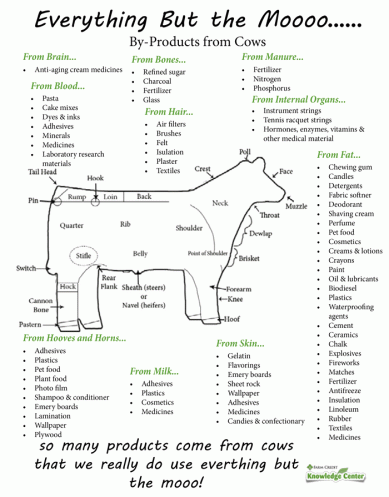
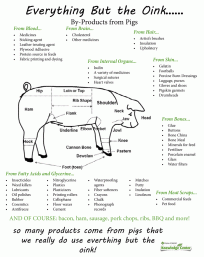
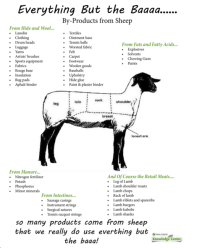
If we did away with livestock products, we would have to reinvent the infrastructure of our food supply and product supply, which would prove to be extremely costly. Thousands of farmers would have their current farming methods they have developed over centuries taken from them. Technology is what has allowed 1 farmer to feed 155 people today instead of 27 people in 1950. Livestock technology is a huge part of that. If we were to abandon animal agriculture, we would see a drastic decrease in food production and an drastic increase in food prices. This would be taking us in the opposite direction of producing enough food to feed a growing population.
3. Millions of Grassland Acres Would Go to Waste Without Livestock
Millions of acres of land are not suitable for crop production (due to slope of terrain, soil type, rainfall, etc.) and are therefore grazed by livestock animals. In fact over 13 million square miles are grazed by livestock animals around the world. These animals help maintain the ecosystem of these grass acres and convert the grass into food for humans. If we took those livestock animals away, the millions of acres of grassland would become unproductive instead of providing billions of pounds of food each year. If our goal is to feed 9 billion people by 2050, this would be a huge step backward in reaching that goal.
4. Livestock Animals Roaming “Free” Is Not Plausible
Currently there are over 11 billion birds, 87 million cattle, 67 million pigs, and 5 million sheep used in U.S. livestock production today. Farmers breed these animals, feed these animals, and protect these animals. They are domesticated. If livestock production ceased, the incentive for farmers to spend their lives caring for these animals would be gone. Farmers would no longer be there to take care of these animals, they would no longer be maintaining fences, caring for the sick, protecting them from predators, etc. Animals would either die out, live in the wild, or live in a zoo. In the wild, livestock animals would no longer be producing food, products, and labor for humans, they would become road hazards and would get into yards, gardens, and public places. They would be a nuisance. The reason these domesticated animals have survived over the generations is based on their importance to humans. Even if sanctuaries were built for large numbers of animals, only a small percentage of the amount we have today would exist.
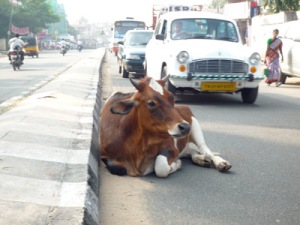
Source: http://bit.ly/1PCf57h
5. Livestock Produce Vast Amounts of Fertilizer Needed to Grow Plants
Without fertilizer, farmers of all types could not grow half as much food as they do. While there are synthetic fertilizers available for farmers to use, many farmers, especially organic farmers, rely on manure from animals to fertilize their crops. Putting nutrients back into the soil through spreading of manure is one of the most natural ways to grow food without depleting the soil and the environment!
6. Livestock Food Products Provide Essential Nutrients
While it is entirely possible to consume a diet free of livestock products, it can be quite difficult. Many people in this world do not have the extra money, time, or discipline to spend avoiding products from animals. Meat, dairy and eggs contain essential nutrients such as protein, calcium, potassium, B vitamins (niacin, thiamin, riboflavin, and B6), vitamin E, iron, zinc and magnesium. Again, the infrastructure of livestock production has allowed for these products to be low in cost and easily accessed.
7. The Livestock Industry Employs Millions of People
If animal agriculture did not exist, millions of people would have to find a job doing something else. This includes jobs in animal production, processing, sales, nutrition, and health. As many know, finding a job can be a struggle no matter what industry you are a part of. Livestock farmers and ranchers have developed and passed down skills and talents over hundreds of years learning how to take care of livestock animals. Colleges and universities around the world have trained thousands of people in different areas of livestock production (see below). Abandoning all of that would be a waste of time and resources and would leave many searching for a job, possessing skills that are no longer needed.
8. The Livestock Industry is a Huge Part of the Economy
The livestock industry provides massive economic benefits to many different countries around the world. In the United States, the numbers are as follows:
- 1,851,000 jobs
- $346 billion in total economic output
- $60 billion in household income
- $15 billion in income taxes paid, and
- $6 billion in property taxes paid
(Source: http://igrow.org/livestock/profit-tips/economic-benefits-of-the-livestock-industry/#sthash.O9ARKhNT.dpuf)
Many countries are struggling economically, but agriculture is usually one of the bright spots in an economy. If animal agriculture were removed from the economy of a country like the U.S., it would be devastating.
9. Many People Rely on Animal Agriculture for Survival
Hundreds of thousands of farm families around the world rely on livestock animals for their survival. There are places where livestock animals are the only thing a family owns besides their home. In wealthier societies, we do have a choice of whether or not to eat meat, but in many places that is not an available choice.
Even in wealthy countries, livestock animals can provide the majority of a farm family’s income due to location (surrounded by pastureland), amount of land owned (not enough to make a living on crops), and climate (grow crops in the summer, livestock in the winter). Families could relocate and adapt to make a living apart from animal agriculture, but it would be unfair and extremely costly to them.
10. Livestock Animals Are a Huge Part of Our Culture
Animal agriculture is a huge part of human history and culture. Livestock farmers and ranchers view working with animals as more than a job. It is a lifestyle that is deeply ingrained in who they are and their purpose here on earth. Millions of children have been raised taking care of livestock to teach them how to do chores, develop a work ethic, and spend time with their family. You can see that in our video, “Takin’ Care of Livestock” linked here: https://www.youtube.com/watch?v=tc1X0CMDDNY&feature=youtu.be
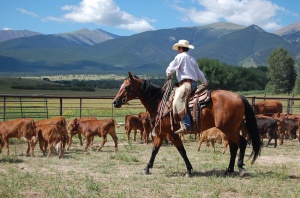
Source: http://bit.ly/1HaBGhh
11. Animal Food Products Taste Amazing
Although tastes and preferences vary tremendously throughout society, most people would agree that the best tasting foods involve animal products! A world without burgers, steaks, eggs, milk, and ice cream would be a sad scenario.
Bottom line: You can choose to avoid animal products for a variety of reasons. You can work to improve animal welfare. And you can continue to ask questions to help keep livestock farmers and ranchers in check. However, the practice of animal agriculture is a very important part of society and the people who are involved in the industry should be supported when they are doing a good job. To see what the current state of the livestock industry looks like, please read the rest of our blogs detailing the life cycles and welfare of different livestock animals. And please, feel free to leave questions at the bottom of this page!

